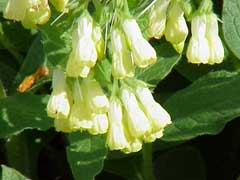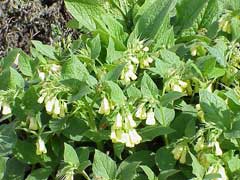 |
|
http://www.kurtstueber.de/ |
 |
| http://www.kurtstueber.de/ |
Translate this page:
Summary
Physical Characteristics

 Symphytum_tuberosum is a PERENNIAL growing to 0.6 m (2ft) by 0.6 m (2ft in) at a fast rate.
Symphytum_tuberosum is a PERENNIAL growing to 0.6 m (2ft) by 0.6 m (2ft in) at a fast rate.
See above for USDA hardiness. It is hardy to UK zone 5. It is in flower from May to June, and the seeds ripen from June to July. The species is hermaphrodite (has both male and female organs) and is pollinated by Bees.
Suitable for: light (sandy), medium (loamy) and heavy (clay) soils and can grow in heavy clay soil. Suitable pH: mildly acid, neutral and basic (mildly alkaline) soils. It can grow in semi-shade (light woodland) or no shade. It prefers moist soil.
UK Hardiness Map
US Hardiness Map
Synonyms
Plant Habitats
Edible Uses
When roasted until brown and brittle, and then finely ground, the root is used as a coffee substitute. It has a smoothness that is not found in real coffee[183].
References More on Edible Uses
Medicinal Uses
Plants For A Future can not take any responsibility for any adverse effects from the use of plants. Always seek advice from a professional before using a plant medicinally.
None known
References More on Medicinal Uses
The Bookshop: Edible Plant Books
Our Latest books on Perennial Plants For Food Forests and Permaculture Gardens in paperback or digital formats.

Edible Tropical Plants
Food Forest Plants for Hotter Conditions: 250+ Plants For Tropical Food Forests & Permaculture Gardens.
More

Edible Temperate Plants
Plants for Your Food Forest: 500 Plants for Temperate Food Forests & Permaculture Gardens.
More

More Books
PFAF have eight books available in paperback and digital formats. Browse the shop for more information.
Shop Now
Other Uses
A good, and sometimes rampant, ground cover plant for a shady border or woodland.
Special Uses
References More on Other Uses
Cultivation details
Tolerates most soils and situations but prefers a moist soil and some shade. Grows well in heavy clay soils. Hardy to about -20°c[187]. Plants form extensive patches, spreading by means of a creeping tuberous rhizome[187]. Plants are dormant in summer[187].
References Carbon Farming Information and Carbon Sequestration Information
Temperature Converter
Type a value in the Celsius field to convert the value to Fahrenheit:
Fahrenheit:
The PFAF Bookshop
Plants For A Future have a number of books available in paperback and digital form. Book titles include Edible Plants, Edible Perennials, Edible Trees,Edible Shrubs, Woodland Gardening, and Temperate Food Forest Plants. Our new book is Food Forest Plants For Hotter Conditions (Tropical and Sub-Tropical).
Shop Now
Plant Propagation
Seed - sow spring or autumn in a cold frame. When they are large enough to handle, prick the seedlings out into individual pots and grow them on in the greenhouse for their first winter. Plant them out into their permanent positions in late spring or early summer, after the last expected frosts. If you have sufficient seed you can try an outdoor sowing in situ in the spring. Division succeeds at almost any time of the year. Simply use a spade to chop off the top 7cm of root just below the soil level. The original root will regrow and you will have a number of root tops, each of which will make a new plant. These can either be potted up or planted out straight into their permanent positions.
Other Names
If available other names are mentioned here
Native Range
TEMPERATE ASIA: Turkey (northwest) EUROPE: United Kingdom, Austria, Switzerland, Czech Republic, Germany, Hungary, Poland, Slovakia, Russian Federation (European part), Moldova, Ukraine (incl. Krym), Albania, Bulgaria, Greece, Croatia, Italy (incl. Sicily), Romania, Serbia, Slovenia, Spain (incl. Baleares), France (incl. possibly Corsica)
Weed Potential
Right plant wrong place. We are currently updating this section.
Please note that a plant may be invasive in one area but may not in your area so it’s worth checking.
Conservation Status
IUCN Red List of Threatened Plants Status :

Growth: S = slow M = medium F = fast. Soil: L = light (sandy) M = medium H = heavy (clay). pH: A = acid N = neutral B = basic (alkaline). Shade: F = full shade S = semi-shade N = no shade. Moisture: D = dry M = Moist We = wet Wa = water.
Expert comment
Author
L.
Botanical References
200
Links / References
For a list of references used on this page please go here
Readers comment
| Add a comment |
|
If you have important information about this plant that may help other users please add a comment or link below. Only comments or links that are felt to be directly relevant to a plant will be included. If you think a comment/link or information contained on this page is inaccurate or misleading we would welcome your feedback at [email protected]. If you have questions about a plant please use the Forum on this website as we do not have the resources to answer questions ourselves.
* Please note: the comments by website users are not necessarily those held by PFAF and may give misleading or inaccurate information.
To leave a comment please Register or login here All comments need to be approved so will not appear immediately.
|
Subject : Symphytum_tuberosum
|
|
|
|